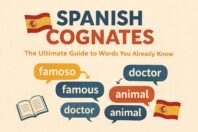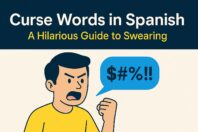Dolor vs Me duele: Using the Spanish Noun and Verb for Pain

Get our free email course, Shortcut to Conversational.
Have conversations faster, understand people when they speak fast, and other tested tips to learn faster.
More infoHave you ever wondered how to express pain in Spanish, but you get confused between dolor, doler, and duele? Well you’ve come to the right place, as in this post we’ll go into the key similarities and differences between these words for describing pain in Spanish.
We’ll start off with the basics, and then go into each word in turn. We’ll cover what verbs and adjectives to use with the noun dolor, along with some variations on how to think about translating dolor in English. Then we’ll cover the verb doler, with its irregular conjugation pattern using duele or duelen with indirect object pronouns. In particular, we’ll consider the best ways to think about duele in English.
Finally, we’ll get into the related adjectives: doloroso and dolorido.
Now let’s dive in!
Dolor, Doler, or Duele?
First and foremost, let’s start with the fact that even though these three words express pain, they are not the same:
Dolor is a noun,
Doler is a verb in infinitive form, and
Duele is the conjugated form of doler.
Dolor is a Noun
Between dolor and doler, you can tell which is a noun and which is an -er verb: dolor is a masculine noun. Let’s see how to use dolor to talk about pain in Spanish.
Verbs with Dolor: Tener dolor or Sentir dolor
You’re probably familiar with how in Spanish we often “have” or “feel” things rather than “are” those things. For example, for our age we are not 24, we have 24 years. We are not thirsty, we have thirst. We are not hot, we feel heat. And the list goes on.
With that in mind, we are not in pain in Spanish: we have pain or we feel pain. Let’s look at this with each of these two verbs.
To have pain – Tener dolor:
- I have a backache. – Tengo dolor de espalda.
- Don’t you have a headache? You drank a lot at yesterday’s party. – ¿No tienes dolor de cabeza? Bebiste mucho en la fiesta de ayer.
- Our legs ache. We walked a lot on the mountain. – Tenemos dolor de piernas, caminamos mucho en la montaña.
Here is the full simple present tense conjugation table for “having pain,” using the verb tener dolor:
| English: to have pain | Spanish: tener dolor |
| I have pain | Yo tengo dolor |
| You have pain | Tú tienes dolor |
| You (formal) have pain | Usted tiene dolor |
| He has pain | Él tiene dolor |
| She has pain | Ella tiene dolor |
| We have pain | Nosotros tenemos dolor |
| You (plural) have pain | Ustedes tienen dolor |
| They (masculine) have pain | Ellos tienen dolor |
| They (feminine) have pain | Ellas tienen dolor |
For a further explanation of tener, check our dedicated post on the uses of the verb tener.
Now let’s see some examples with sentir dolor, to feel pain:
- I feel a mild pain in my hand. – Siento un dolor leve en mi mano.
- Did you feel pain after the surgery? – ¿Sentiste dolor después de la cirugía?
- They should not feel pain tomorrow, it was a quick training. – Ellos no deberían sentir dolor mañana, fue un entrenamiento rápido.
Now we have the present conjugations for feeling pain using sentir dolor:
| English: to feel pain | Spanish: sentir dolor |
| I feel pain | Yo siento dolor |
| You feel pain | Tú sientes dolor |
| You (formal) feel pain | Usted siente dolor |
| He feels pain | Él siente dolor |
| She feels pain | Ella siente dolor |
| We feel pain | Nosotros sentimos dolor |
| You (plural) feel pain | Ustedes sienten dolor |
| They (masculine) feel pain | Ellos sienten dolor |
| They (feminine) feel pain | Ellas sienten dolor |
[Body part] pain: Dolor de …
In order to express aches, the only thing we need to do is to say: dolor + de + part of the body in pain:
- Headache – Dolor de cabeza
- Toothache – Dolor de diente
- Stomach ache – Dolor de estómago
And the list goes on and on. Not enough vocab for all the parts of the body? Don’t worry, you can always check this list of body parts in Spanish.
Intensity of pain: Dolor …
Now, here are some adjectives indicating the intensity of pain we feel. This goes from a mild pain to a chronic one.
| English | Spanish |
| Mild pain | Dolor leve |
| Moderate pain | Dolor moderado |
| Strong pain | Dolor fuerte |
| Sharp pain | Dolor intenso |
| Severe pain | Dolor severo |
| Chronic pain | Dolor crónico |
Doler is a Verb
Recognize doler as a verb thanks to its common -er ending. Doler conjugation, however, is less straightforward. If you’re familiar with the verb gustar, doler follows the same format using indirect object pronouns. In short, we need to think about the source of the pain as doing the action, with the person feeling this pain as the indirect object.
Doler conjugation
Does this conjugation sound confusing? Rather than thinking that your brain hurts right now, think how your brain is hurting you: te duele el cerebro. Your brain “el cebrero” is technically the subject, so doler is conjugated in third-person singular form duele to match. You’re the indirect object of this pain with the pronoun te. Here’s our conjugation table:
| doler present conjugation, singular | doler present conjugation, plural |
| [indirect object pronoun] duele | [indirect object pronoun] duelen |
To get the hang of this, let’s see the doler conjugation with a variety of subjects (source of the pain) and indirect objects (feeling the pain). See how the conjugation is always in the third person, whether in singular or plural depending on the source(s) of the pain (shown here in bold).
If we want to emphasize the person who’s experiencing the pain, we can add a redundant object prefaced with the preposition a.
- My hands hurt. – A mí me duelen las manos.
- Your stomach hurts because you ate a lot. – Te duele el estómago porque comiste mucho.
- Her neck hurts because she is stressed. – A ella le duele el cuello porque está estresada.
- Our legs hurt after running that marathon. – A nosotros nos duelen las piernas después de correr esa maratón.
- Their arms hurt after lifting weights at the gym. – Les duelen los brazos después de levantar pesas en el gimnasio.
Doloroso and Dolorido are Adjectives
So far we’ve talked about pain, both using the noun dolor when we have or feel pain, and with the verb doler for when something is causing us pain. The two adjectives we’ll look at now share the same root, and can be used to describe things that are painful or sore. Let’s see each of them. Remember that as adjectives, the endings of these words need to change to match the gender and number of whatever they’re describing.
Doloroso is used to describe something that’s painful. As in English, we use the same word when talking about both physical or emotional pain.
- Tony’s fall was painful. – La caída de Tony fue dolorosa.
- Gustavo’s funeral was painful for everyone. – El funeral de Gustavo fue doloroso para todos.
- Some vaccines are painful. – Algunas vacunas son dolorosas.
- Contact sports can be painful. – Los deportes de contacto pueden ser dolorosos.
Dolorido is used to describe a person or part of the body that’s sore. Whether it’s after a good gym workout, following a long hike in the mountains, or at the end of the day helping a friend move house, dolorido is the word we’ll use to say how we’re feeling the next day!
- I have a sore neck because I slept badly. – Tengo el cuello dolorido porque dormí mal.
- Sitting improperly can leave us with a sore back. – Sentarse inapropiadamente puede causarnos una espalda dolorida.
- I won’t go to the gym, I’m sore! – ¡No iré al gimnasio, estoy dolorido!
- They lifted so many things that now they have sore arms. – Ellos levantaron tantas cosas que ahora tienen los brazos doloridos.
Adolorido is another very similar word you might hear, though we’re only pointing it out as a warning! The correct word to use is dolorido, however, you’ll often hear people using adolorido interchangeably. This misuse of the word is common enough, even though adolorido isn’t technically a word.
Conclusion
Well that covers it! Are you clear now on how best to say “tengo dolor” or “me duele” in English? We started off looking at the key differences between dolor and doler (noun vs verb), as well as some verbs and adjectives to use with dolor. We spent some time examining the particular conjugation of doler, with its reliance on indirect object pronouns. We also saw how to express the intensity of pain. Finally, we ended by learning a couple of dolor-related adjectives: doloroso and dolorido.
We are all set! It was not that difficult, was it? Now are you ready for some practice on these concepts? Break a leg! Just not literally, because eso duele!
Exercises: Dolor vs Doler vs Dolorido vs Doloroso
If you think you’ve got these different dolor words straight, why don’t you try these exercises by choosing the right option from the choices.
1. ________ (Tengo dolor / Dolorido) en mi hombro.
2. ¿Estás bien? Parece que ________ (te duele / tienes dolor) la cabeza.
3. A nosotros ________ (nos dolemos / nos duelen) los brazos luego del partido.
4. La muerte de tu esposa debió ser ________ (dolorida / dolorosa).
5. Siento mucho ________ (duele / dolor) en mi estómago.
6. Patear un mueble con el dedo pequeño del pie es muy ________ (dolorido / doloroso).
7. Luego del ejercicio, me siento muy ________ (dolor / dolorido).
8. Voy al spa por mi ________ (duelen / dolor) de espalda.
9. Estoy seguro de que ________ (te duelen / te dueles) las pantorrillas por jugar vóley.
10. ________ (Me duele / Es doloroso) para mí que hables del tema, solo han pasado un par de días.
Answers
1. Tengo dolor en mi hombro. – My shoulder hurts.
2. ¿Estás bien? Parece que te duele la cabeza. – Are you ok? It looks like your head hurts.
3. A nosotros nos duelen los brazos luego del partido. – Our arms hurt after the match.
4. La muerte de tu esposa debió ser dolorosa. – Your wife’s death must’ve been painful.
5. Siento mucho dolor en mi estómago. – My stomach hurts very much.
6. Patear un mueble con el dedo pequeño del pie es muy doloroso. – Kicking a piece of furniture with the little toe is very painful.
7. Luego del ejercicio, me siento muy dolorido. – After exercising, I feel very sore.
8. Voy al spa por mi dolor de espalda. – I go to the spa because of my backache.
9. Estoy seguro de que te duelen las pantorrillas por jugar vóley. – I am sure that your calfs hurt from playing volleyball.
10. Es doloroso para mí que hables del tema, solo han pasado un par de días. – It is painful for me that you talk about the topic, it’s been only a couple of days.



